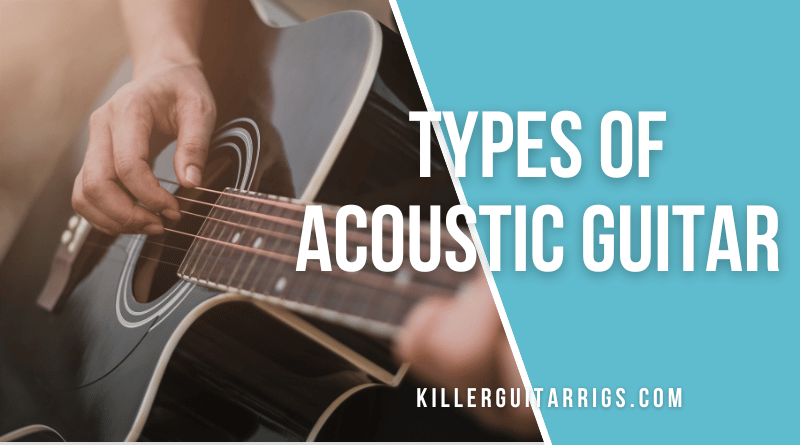Acoustic guitars come in many shapes and sizes, and this can be an extremely confusing thing for newer players to navigate. In many cases beginners gravitate straight to the dreadnoughts because that’s just what they know, but this could actually be slowing down progress.
By learning all about the different types of acoustic guitar on the market, you’ll be able to find out which suits your style, and even your body, best. This will ensure you have the most comfortable playing experience possible, and also tones that suit the style of music you prefer to play.
In this KillerGuitarRigs Guide, we break down all of the major acoustic body styles to bring you a bit of history about each, plus some information on their shape, their comfort and playability, and of course, their tones.
If you’re in the market for a new acoustic guitar and you’re not quite sure where to start, make sure you keep on reading.
Contents
Dreadnought
Dreadnoughts are some of the most popular guitars on the market thanks to their incredible tone and huge versatility.
History
Although they’re now thought of as the acoustic guitar, dreadnoughts are actually one of the more contemporary designs on the market. This body shape has been around since about 1916, and was invented by the CF Martin Company, better known today as Martin Guitars.
The earliest dreadnoughts were made by Martin, but interestingly enough, for the first four years they were made for another brand, Ditson Guitars. In 1920, Ditson Guitars went under, however, and the dreadnought design sat dormant for another 11 years until 1931, when Martin added the D-1 and D-2 to their product catalog.
Shape
Dreadnoughts are some of the most distinctive looking guitars on the market. With some of the other body styles, you might find yourself confused, but there’s no mistaking a dreadnought for anything else.
These guitars are known for their big, boxy bodies. They are amongst the widest and deepest of all the acoustic shapes, and feature broad, squared off shoulders, a thick waist, and a lower bout that is only marginally wider than the shoulders.
While the “typical” dreadnought has square shoulders, companies like Gibson are known for their slope shoulder models. Aesthetically they are quite different, but tonally there is no objective way to establish the difference between the two styles.
Many other factors, including the wood, bracing style, and bridge all have a huge influence on tone. So, for example, comparing a Martin D-18 to a Gibson J-45 is inherently a flawed test.
Comfort/Playability
Because of their big bodies, dreadnoughts are notorious for their relative discomfort compared to other styles. Smaller players will find the large, boxy shape difficult to handle, which can ultimately affect form while playing.
There are some slimline dreadnoughts available, which do improve the comfort factor quite noticeably, although some might argue that the playability benefits don’t outweigh the loss of volume that occurs with slimmer models.
Tone
Dreadnoughts are best known for their big, booming voices. They have exceptional projection and volume, and regardless of the tone woods used, they have a big bottom end and a strong presence in the mids and lower mids.
Our Favorite Dreadnought
Martin D-X2E
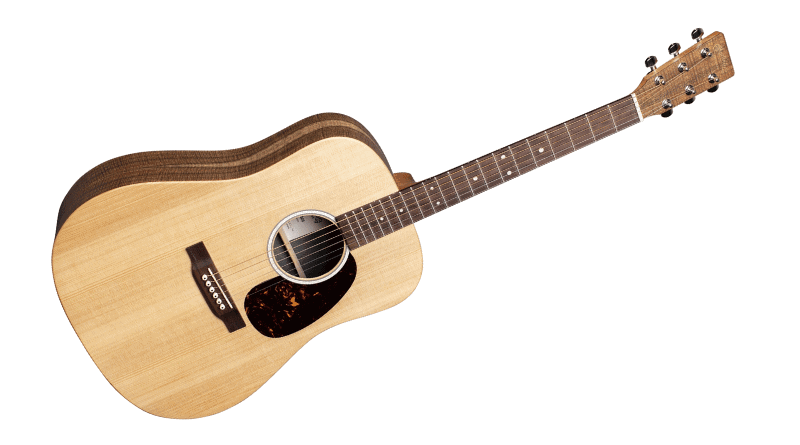
Highlights:
- Incredible projection
- Gorgeous koa back and sides
- Fishman electronics
Jumbo
Jumbo guitars are the largest of the modern acoustic guitar family and provide a great way to get huge volume and incredible presence.
History
Jumbo style acoustics are another contemporary design, with a history dating back to around 1936. That year, Gibson produced the Advanced Jumbo, a dreadnought style acoustic with more rounded shoulders. It was intended to be a competitor to Martin’s Dreadnought models, but unfortunately it just didn’t catch on.
So, after just 300 examples were built, Gibson killed the Advanced Jumbo, and by 1937 released what was to be their flagship flattop acoustic – the Super Jumbo. This is the guitar that is now recognized as the jumbo style.
Shape
Jumbo by name, jumbo by nature! Jumbo guitars are amongst the largest you’ll find anywhere. They have enormous soundboards thanks to their rounded, pronounced shoulders and bulbous lower bout with a narrow waist.
The proportions of the shoulders and lower bout do tend to change between manufacturers. For example, Gibson jumbos tend to look like more of a figure 8 because the top and bottom bouts have a very similar width. Alvarez make their jumbos with slightly narrower shoulders, making the bottom look more pronounced.
Comfort/Playability
Jumbo acoustics are fairly polarizing when it comes to comfort and playability. As the largest of the standard size acoustic guitars, jumbos may simply be too large for smaller players to comfortably handle.
However, the jumbo’s narrow waist is its secret weapon in terms of comfort. The thin waist makes it much more stable when played in the seated position because the guitar can rest comfortably on a knee without moving.
Tone
Because of their enormous size and the huge volume of air in the cavity, jumbo guitars have a big, bold tone with a lot of bass. They also have strong presence in the mids, and the highs tend to be very crisp.
These guitars are loud, and are best suited to heavy strummers, as they require a lot of work to get the maximum performance out of them. Hitting big, open chords results in a kind of sonic magic. Unfortunately, delicate styles like fingerpicking tend to sound a little washed out on jumbos, but that’s purely because they need a lot of energy put into them to get the air moving from the cavity.
Our Favorite Jumbo
Epiphone J-200
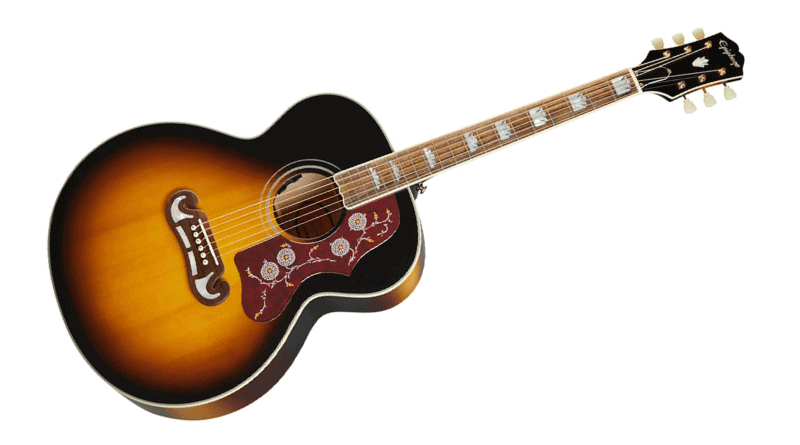
- Highlights:
- Gorgeous aesthetics
- All solid woods
- Extremely comfortable neck
Auditorium (000)
Auditorium guitars are a great middle of the road size for players who play a bit of everything and don’t want multiple instruments.
History
The auditorium body shape, or 000 as it’s sometimes known, has little in the way of documented history, but most tend to credit Martin as the original designer of the shape. It first appeared in the Martin catalog in 1902, and at the time was the biggest guitar they made.
The intent of increasing the size was the search for more volume. The guitar was seeing more widespread use in bands and groups, and in order to keep up with the banjos and mandolins, Martin simply made their 00 guitars bigger!
Shape
Auditorium/000 guitars are a size down from dreadnoughts, making them something of a larger medium model. Like jumbo guitars, they have a very narrow waist in relation to their upper and lower bouts, giving them a figure 8 silhouette.
Not only are they shorter and slimmer than dreadnoughts, but the body is also shallower.
Comfort/Playability
Playability is a real strong point for auditorium style guitars. The shallow body makes them easy for players of all shapes and sizes to hold comfortably, and the distance from the edge of the guitar to the strings is shorter than it is on jumbos and dreadnoughts, making them much easier to wrap your arm around.
The narrow waist ensures excellent comfort while playing from a seated position, and the shallow body depth also makes it easy to play when standing, too. They also tend to have a shorter scale length than jumbos and dreadnoughts, at around 24.8” rather than the 25.3” you’d find on the larger models, further increasing the comfort factor.
Tone
The auditorium body shape is prized for its incredibly balanced tone. Across the lows, mids and highs on every string, these guitars offer a tonal equilibrium unlike any other style. Because the soundboard on this shape is quite large, it’s also capable of producing a lot of volume, too.
The shorter scale of auditorium guitars also helps to reduce the string tension, too, which makes them great for lead playing, as bends and single note runs are far more comfortable than they are on the big models. Overall, these are very punchy sounding guitars that work well for a huge range of players.
Our Favorite Auditorium Guitar
Martin 000-10E
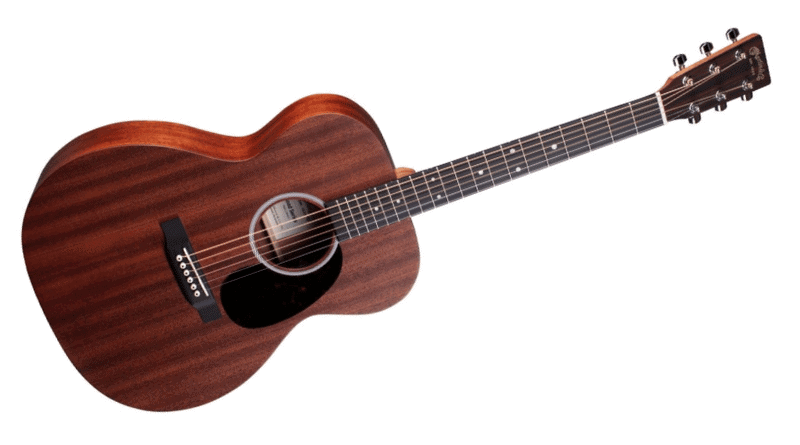
Highlights:
- All solid sapele construction
- Amazing responsiveness
- Great fingerpicking performance
Grand Concert (00)
The grand concert style was amongst the first modern steel strung acoustics, and still delivers a classic vintage tone.
History
The grand concert, or 00 as it’s otherwise known, has been in the Martin lineup since at least the 1870s, but there’s a good chance it stretches back even further to the 1850s. Again, at the time, it was the largest guitar Martin made (until the 000), and got the name “Grand Concert” because it was large enough for use with a large concert audience.
It’s a style that has remained popular throughout its entire life, and with over 150 years of continuous production, that should say everything you need to know about the grand concert.
Shape
Grand concert guitars are a step down from the 000 auditorium size, and are considered to be a small bodied style. The dimensions of a 00 GC guitar are extremely similar to that of a classical guitar, with rounded upper and lower bouts, and a moderately thin waist. The key difference is that grand concert guitars are quite a lot shallower.
Comfort/Playability
Because of their small size, grand concert style acoustics are extremely comfortable players, and offer a similar feel to parlor guitars, but because their bodies join at the 14th fret, they offer improved playability for those looking to explore the fretboard a little more.
Their shallow body depth makes it easy to get arms around the guitar, so it’s a comfortable choice for most players, including kids and smaller adults. This style is about as good as it gets for fingerstyle players.
Tone
Tonally the 00 grand concert style is one of the sweetest sounding guitars you’re ever likely to hear. Despite its smaller body, it still delivers a beefy bass response, and its mid range and upper frequencies are also pretty potent.
These guitars offer a ton of shimmer, which really helps them to stand out when being played fingerstyle. They are some of the easiest guitars to mic thanks to their natural balance, so if you’re looking to record, you’ll find that grand concert models make great studio guitars.
Our Favorite Grand Concert Guitar
Martin 00-15M
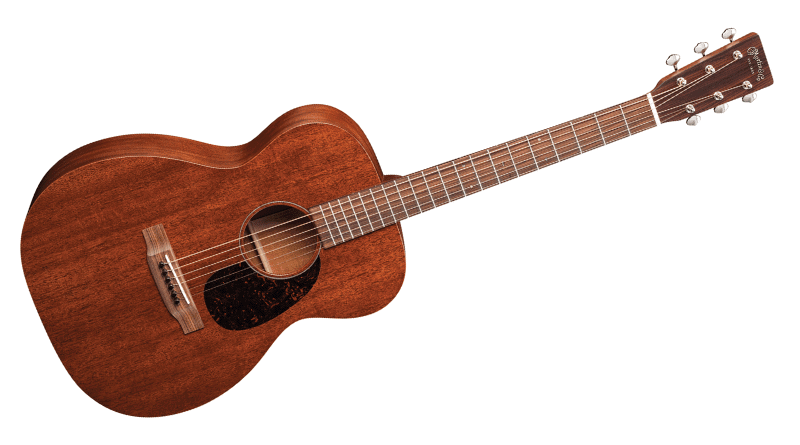
Highlights:
- All solid mahogany construction
- Made in the USA
- Beautiful warm tones
Grand Auditorium
The Grand Auditorium is one of the newest shapes, and was developed within the last 30 years. It has beautiful proportions and sounds as good as it looks.
History
While we’ve referred to the likes of the dreadnought and the jumbo as contemporary designs, the Grand Auditorium has them both beat in terms of youth. This shape was designed by Bob Taylor of Taylor guitars in 1994.
The shape was a runaway success for Taylor. It had a lot to do with the rapid rise in popularity for Taylor through the ‘90s, and is to this day the shape they’re best known for. Other brands saw just how popular this shape was becoming, and hopped on the GA train, and today almost every major acoustic guitar manufacturer makes guitars in this style.
Shape
The grand auditorium is a curvy model with rounded shoulders and a rounded bottom half. It’s not quite as circular as a jumbo, but this is primarily down to the slightly broader waist that results in a less bulbous look. GA guitars are widely accepted as some of the prettiest looking acoustics, and this is largely down to the practically perfect proportions.
They sit right in between the dreadnought and auditorium size-wise, and sit at the larger end of the medium size spectrum.
Comfort/Playability
Because of how recently the grand auditorium was designed, the technology available to luthiers was far in excess of anything available when more classic models were conceived. As such, the ergonomics on the GA are some of the best on any acoustic shape.
It’s an extremely comfortable body shape with great balance, and is easy to play from both seated and standing positions.
Tone
Tonally, the grand auditorium is another extremely well balanced guitar, rivaling the auditorium for responsiveness across the entire frequency spectrum. The design really allows it to shine when fingerpicking, while still giving it enough presence to handle big open chord strumming.
Definition is generally exceptional with GA models, regardless of tonewood type. These guitars can easily blend into a mix, or cut right through if necessary, making them a great option for players who take on both lead and rhythm roles.
Our Favorite Grand Auditorium Guitar
Taylor 114ce
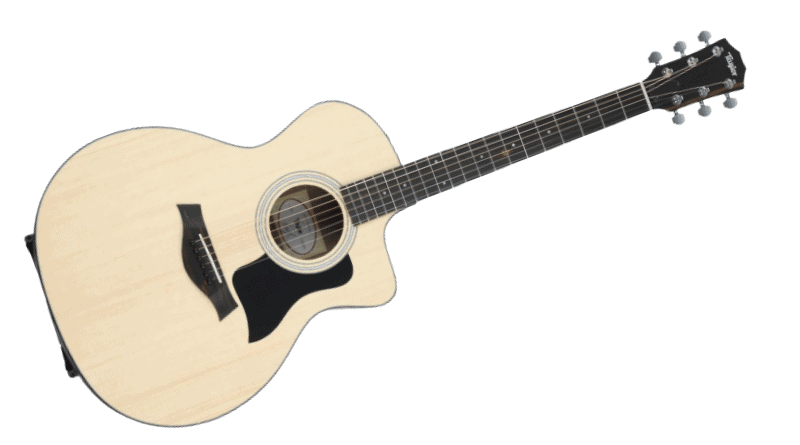
Highlights:
- Beautiful Sitka spruce top
- High end Taylor electronics
- Superb reliability
Classical
Modern guitar music owes everything to the humble classical guitar. This is the origin of the species, and despite being the oldest of the acoustic shapes, it still maintains its own place in both classical and folk styles.
History
Classical guitars have the longest and therefore murkiest history of any acoustic styles. Because they’ve been around for centuries in different countries and across different continents, the exact story of their origin depends on who you ask. It is, however, generally accepted that they evolved from the vihuela and gittern, two 15th century Spanish stringed instruments.
The invention of the rail network in the 19th century brought about new interest in the classical guitar across Europe, which led to the rapid development from the baroque and romantic period classical guitars, to what we now consider to be a classical guitar today.
Classical Guitar Body Shape
Classical guitars have mid sized bodies, smaller than the auditorium size, and have a similar shape to the 00 style. Like many classical instruments, they are available in several sizes, with full size models being referred to as 4/4.
Though the body shape is similar to the 00 (Grand Concert), classical guitars have much more body depth – This helps enormously with projection.
Unlike steel strung models, classical guitars have fretboards that join the body at the 12th fret, not the 14th. There tends to be less need to play above the octave on classical guitars, so more fretboard access simply isn’t necessary.
Comfort/Playability
There are a few facets to highlight with the comfort and playability of classical guitars. They have nylon strings, which by all accounts have very low tension and are very comfortable on the fingers. The downside is that they have extremely wide necks, which can make it difficult for players with smaller hands to get comfortable.
In addition to that, traditional classical guitars don’t have strap buttons, as they’re intended to be played from a seated position. This does limit options, that is unless you’re willing to make some modifications to your guitar.
Tone
Classical guitars are traditionally built with cedar tops, which deliver lots of warmth and pronounced overtones. They have tons of character, and an extremely mellow voice. While mostly used for classical music, some players are known to play nylon strung acoustics and classical guitars for folk styles, and this is largely down to their superb performance when played fingerstyle.
Classical guitars have so much nuance that would most likely be lost if played with a pick. They’re delicate sounding, with the majority of their focus in the upper mids and trebles, giving them a fantastic shimmer that really can’t be replicated by any steel string guitar.
Our Favorite Classical Guitar
Cordoba C7
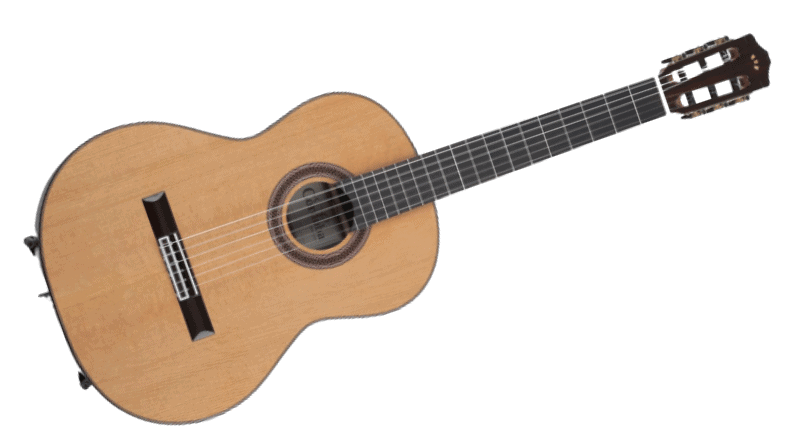
Highlights:
- Canadian red cedar top
- Gorgeous rosewood back and sides
- Fantastic tuning stability
Parlor
Parlor guitars are so much more than travel and couch guitars – they kickstarted the blues revolution in Mississippi, creating a ripple that is still growing today.
History
Parlor guitars have been around since the late 19th century, and once again their invention is thanks to Martin. Although Martin Didn’t directly invent the parlor, their bracing technology that allowed for a guitar to use steel strings allowed luthiers to install steel strings on the smaller bodied guitars of the time, and the parlor guitar was born.
They became popular due to their compact size, which made them excellent travel guitars, but most of all, made them comfortable to play from an armchair. This made them extremely popular for household entertainment in a time before television and widespread radio access – hence the name, parlor guitar.
Shape
Parlor guitars have a unique, elongated soundboard. They are tall and narrow, which helps enormously with comfort while reducing the tonal sacrifice made due to the size. Their bodies have a mid size depth – they aren’t the shallowest, but they’re still much slimmer than a dreadnought.
The bottom bout is noticeably wider than the shoulders, and they have a cinched waist that comes in very close to the edges of the sound hole, giving them an almost paddle like appearance.
Comfort/Playability
The parlor guitar style is easily one of the most comfortable shapes ever designed. Its entire purpose is to prioritize playability above all else. They are lightweight and extremely compact so players of all sizes and ages should find them comfortable to play whether seated or standing.
Parlor guitars often have a short scale length, but because the fretboard meets the body at the 12th fret, the access to upper frets is fairly limited. As long as you’re not trying to play Van Halen style solos, you should be fine with the range afforded.
Tone
Parlor guitars offer a huge amount of volume for a small guitar. This is because the design allows for a lot of soundboard real estate without making the guitar bulky. The moderate body depth also goes a long way to helping with the volume and projection.
Parlor guitars tend to be very mid range focused instruments, with a lot of punch that works extremely well for delta blues and even slide guitar.
Our Favorite Parlor Guitar
Gretsch G9500 Jim Dandy
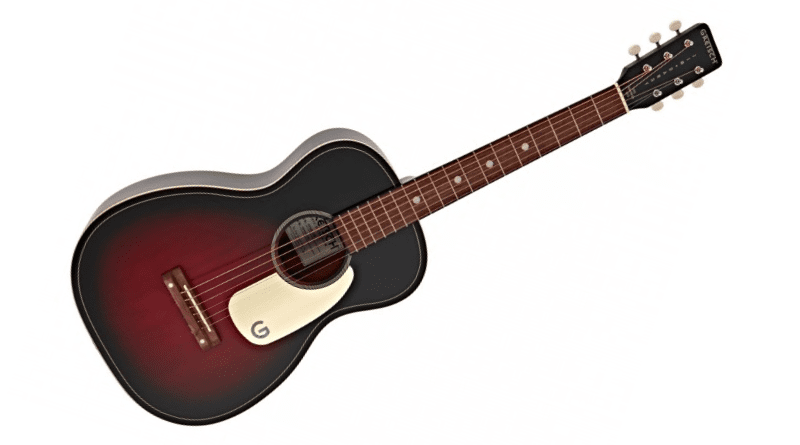
Highlights:
- Incredible value
- Amazing vintage aesthetics
- Robust tone
Final Thoughts on the Types of Acoustic Guitar
As you’ve learned throughout this guide, the body shape of an acoustic guitar has as much, if not more influence on its tone and character than the choice of woods used. By understanding this, you’ll find the most comfortable guitar for you, and still get the kind of sound you’re looking for.

